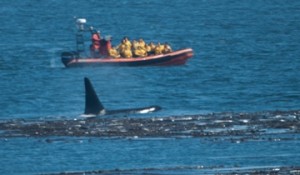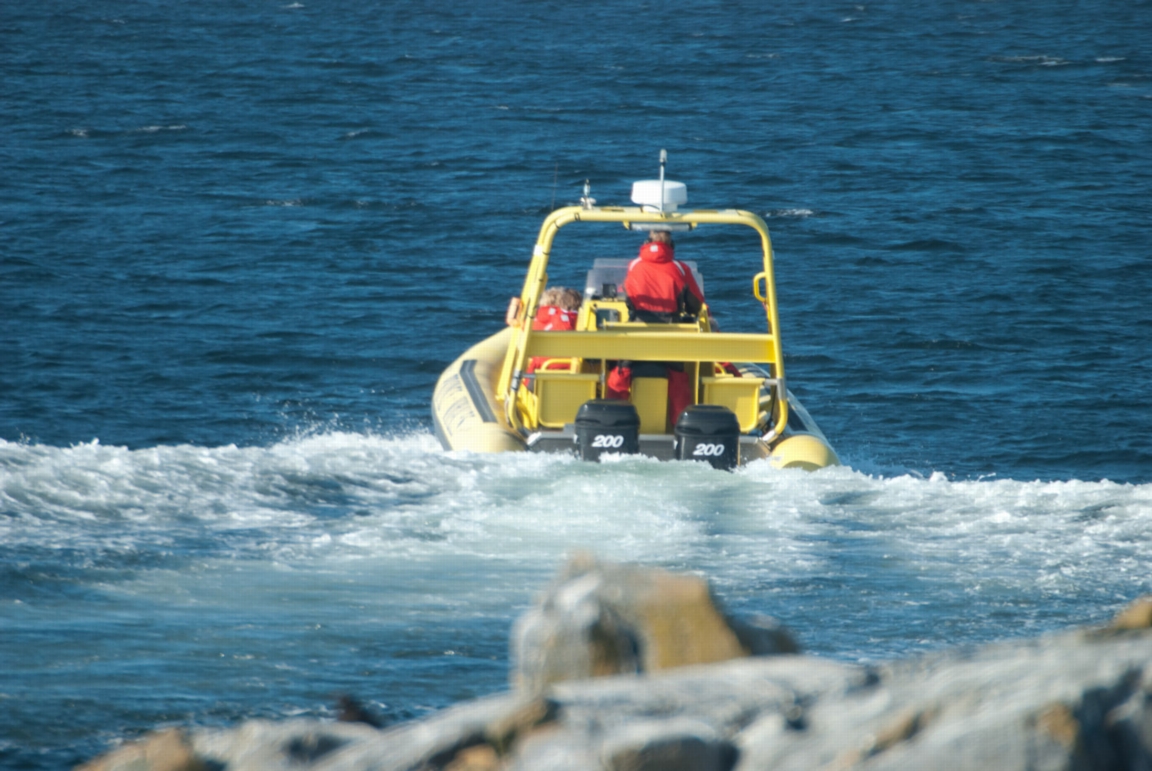Orca’, 10, ‘The last three days have been the most beautiful I’ve ever experienced out here. The wind is flat calm, the sea like is glass and the air is warm. Yesterday evening about eight to ten orcas of the southern resident population swam eastbound around and through the Reserve. There are four populations of orcas in the eastern Pacific Ocean, the southern residents being the smallest. The southern residents consistent of one clan -J) and three pods -J, K and L), with several matrilines within each pod. The southern residents are the only orcas listed as endangered by the US Fisheries and Wildlife Service and there are approximately 87 individuals making up the population. The population is a hierarchical one built upon the matrilineal system whereby groups of individuals are connected by maternal descent. Each matriline consists of a female, her sons and daughters, and the offspring of the daughters. A matriline may consist of one to seventeen individuals and up to five generations. Pods are groups of matrilines connected by a common female ancestor. Hunting techniques and vocalisations in the orca species are specific to groups of individuals and are passed along these ancestral paths; the specificity and uniqueness of these habits have been described as manifestations of culture by some. Worldwide, there are three different types of orcas that have been described as different races or subspecies: residents, transients and offshore orcas. Resident orcas are fish-eaters and exhibit complex social structures -as described above, the orcas frequenting Race Rocks are one of four of the northeast Pacific resident populations). Resident orcas will frequent the same area through their lives and the southern residents are among the most intensively studied marine mammals in the world. Over the last 30 years, scientists have identified and named over 300 individuals. Transient orcas exclusively eat marine mammals. They do not exhibit the complex social structures seen in the resident populations, and will travel widely in their lifetime–some individuals have been spotted in both California and Alaska during their lifetimes. Offshore orcas are the third type and were only discovered in 1988. They primarily travel far offshore and eat schooling fish. They may congregate in groups of about 200 individuals. Very little is known about offshore orcas. Resident and transient orcas are genetically isolated and have not interbred for approximately 10 000 years; researchers estimate that the evolutionary split between residents and transient occurred about two million years ago. The southern resident orcas, listed as an endangered species, face a plethora of anthropogenic threats. Up to 90% of the orca ”s diet consists of salmon, with chinook -king) salmon being by far their favourite. However, over the last half-century, many wild salmon runs on the Pacific Coast have become extinct due to overfishing and loss of habitat. Furthermore, some scientists believe that orcas dive up to 800 feet in search of rockfish. With rockfish in the Salish Sea having declined to 2% of historical levels since 1950, orcas face incredible pressure to search for the appropriate amounts of food to sustain themselves. Some scientists believe that the depletion of fish stocks in the Salish Sea may be causing changes in movement patterns of the southern resident population. The resident orcas must also contend with unacceptably high levels of toxins in their environment. Because orcas are at the top of the food chain and because toxins accumulate in higher concentrations as they move up the food chain, orcas accumulate considerably more toxins than other marine mammals. Studies of dead and stranded southern resident orcas have shown extremely high levels of lead, mercury and poly-chlorinated hydrocarbons -PCBs). PCBs are an endocrine disruptor, meaning that they interact and have adverse affects on the hormonal system of the body. One of the most dire consequences of this interaction is on the development of offspring, as the endocrine system is one of the big factors playing into the growth and development of offspring during gestation. Obviously, reducing the level of toxins in the environment would require sweeping societal changes. Some PCBs were banned in the 1970s, but due to their nature, PCBs tend to build up and do not disintegrate. In the case of the Salish Sea, they accumulate in orcas. Some scientists reckon that toxins such as PCBs are the biggest threat orcas face, even more so than depleting fish stocks. To add fuel to the fire: because fish stocks have been depleted so much, orcas must eat more small fish in order to meet their nutritional requirements. However, eating more small fish means that orcas ingest more toxins than they would if they were eating fewer large fish. Thus, more small fish means more toxins, a double-whammy effect. A third pressure orcas in the Salish Sea face is from boating. The Strait of Georgia, the Juan de Fuca Strait and Puget Sound are all areas of high vessel traffic. Collision avoidance -or not), air pollution and noise all put pressure on the population. In short, the southern resident orcas, an infamous symbol of the Salish Sea, face an already large, and growing, list of threats. Their intelligence and culture alone are symbols of a species deserving merit and protection. They have as much right to be here as we do, and we must give them the respect they deserve. When viewing whales, be sure to follow the ”Be Whale Wise ” guidelines found at http://www.bewhalewise.org/. If you take a trip on one of the many whale watching boats in the Victoria area, be sure to ask your guide about their policies towards viewing and respecting the rights of whales. There is a plethora of information that can be found on the web about the southern resident orcas if you seek more information.’, ‘Adam’, ’08:34:27 ,


